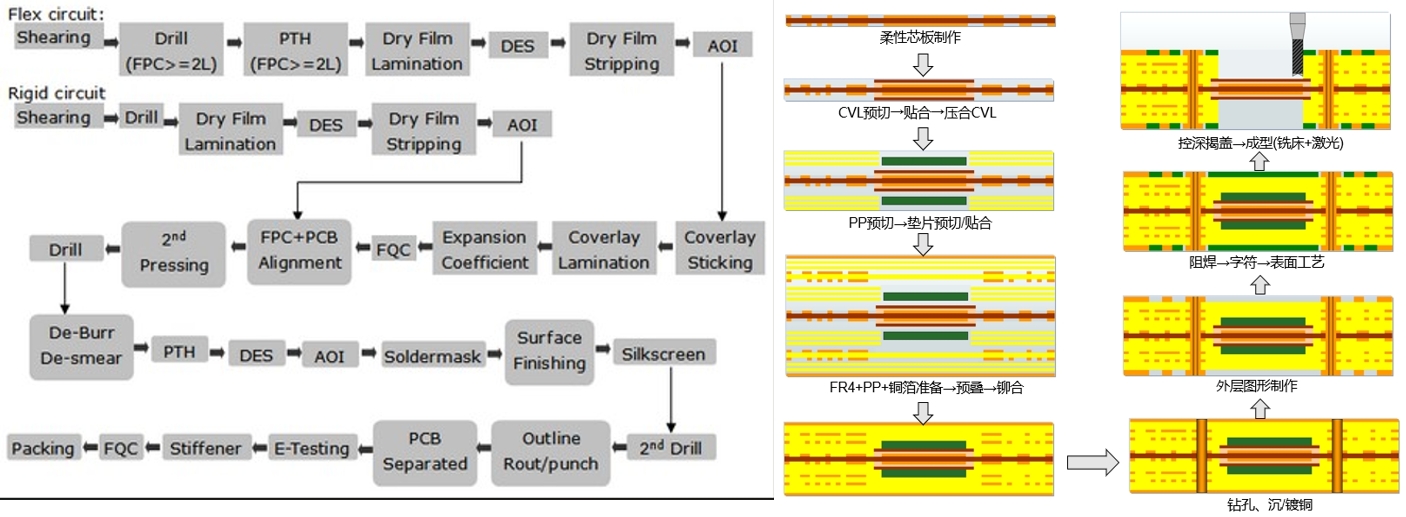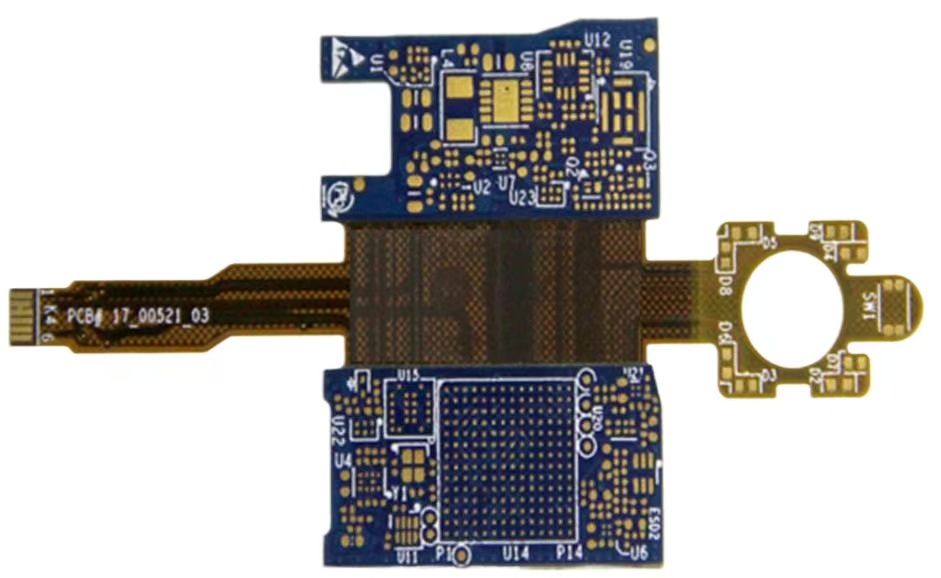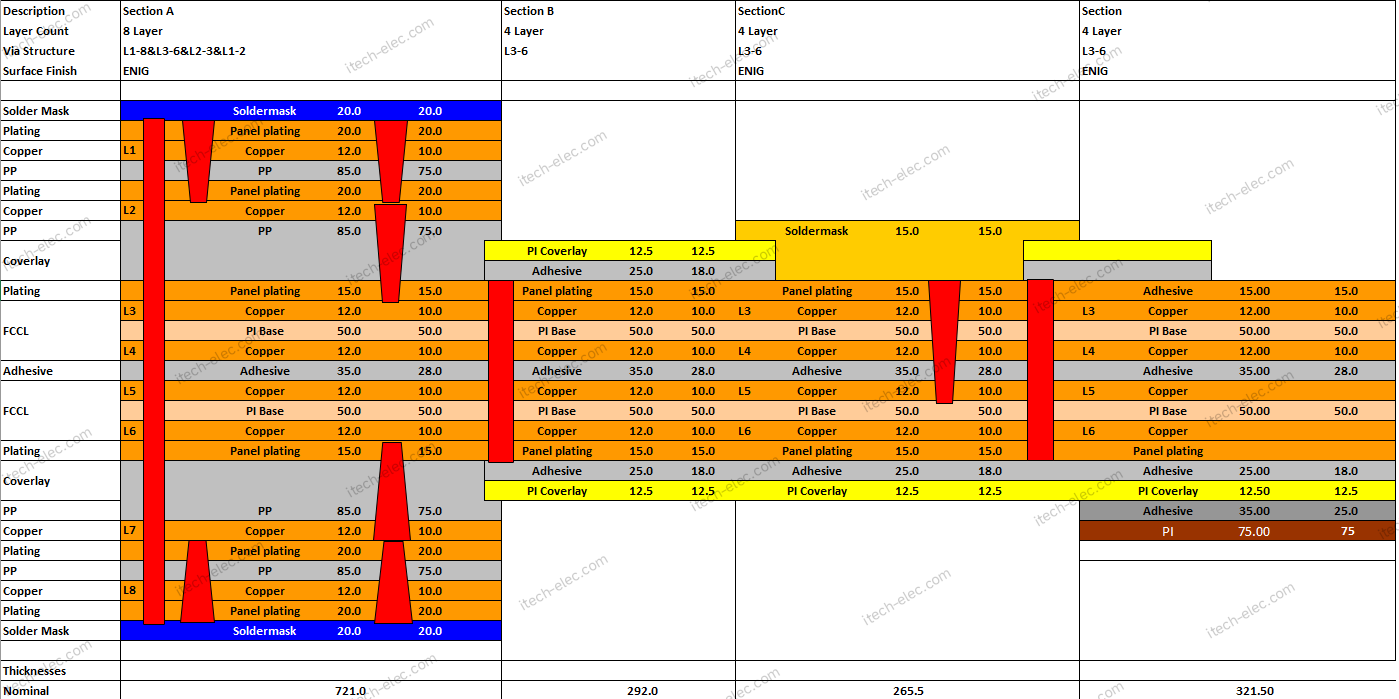HDI Rigid - Flex PCBs with Blind and Buried Vias: A Technological Leap
HDI Rigid - flex PCBs equipped with blind and buried vias are an advanced version of traditional ones. Blind vias connect outer to inner layers without going through the whole board, while buried vias link inner - layers, hidden from the outer surface.
In the rigid part of these PCBs, these vias are crucial. Made from materials like FR4, the rigid sections can precisely hold the vias created by laser - drilling or other advanced techniques. This boosts component density, improves electrical performance, and shrinks the rigid part's size, making it perfect for compact devices.
For the flexible part, blind and buried vias add new functionality. Even with the flex material's bendability, they ensure reliable electrical connections and enable a more complex layout to handle more signals. This is especially useful when the flexible part is frequently folded or bent, as the vias keep connections intact.
The use of blind and buried vias in both rigid and flexible sections offers multiple benefits. It improves signal integrity, cuts down crosstalk, and enhances circuit reliability. It also simplifies the design by reducing surface - level connections. As a result, this type of rigid - flex PCB is in high demand in high - end electronics such as aerospace gear, medical devices, and advanced mobile gadgets, where space is limited and performance matters most.
Vantage of Rigid-Flex PCB
Enhanced Component Density:
In HDI Rigid - Flex PCBs, the combination of blind and buried vias allows for a substantial increase in component density. Blind vias, which connect outer layers to inner - layers without traversing the entire board, and buried vias, linking inner - layer to inner - layer, enable a more compact and efficient circuit layout. This means that more components can be packed into a smaller space, making it ideal for applications where size is a crucial factor, such as in portable electronics like smartwatches and compact medical devices.
Superior Signal Integrity:
These vias play a vital role in improving signal integrity. By reducing the length of signal traces and minimizing the chances of signal interference and crosstalk, HDI Rigid - Flex PCBs ensure that signals are transmitted accurately and efficiently. This makes them highly suitable for high - speed data transmission applications, such as in 5G communication devices and high - performance computing systems.
Greater Design Flexibility:
The flexible sections of HDI Rigid - Flex PCBs, along with the advanced via technology, offer greater design flexibility. Designers can create more complex and customized circuit layouts to meet the specific requirements of different products. Whether it's a product with a unique form factor or one that needs to accommodate multiple functions in a limited space, HDI Rigid - Flex PCBs can be tailored accordingly.
Weight and Size Reduction:
Thanks to the high - density interconnect technology and the ability to integrate more components in a smaller area, HDI Rigid - Flex PCBs contribute to significant weight and size reduction in the final products. This is especially beneficial in applications where portability and space - saving are essential, like in aerospace and mobile devices.
Reliability and Durability:
Despite the complexity of the design, HDI Rigid - Flex PCBs are highly reliable and durable. The use of high - quality materials and advanced manufacturing techniques ensures that the blind and buried vias maintain their integrity even under harsh environmental conditions, such as temperature variations and mechanical stress. This makes them suitable for a wide range of applications, from industrial equipment to automotive electronics.
Advanced Features Incorporation:
Similar to traditional rigid - flex PCBs, HDI Rigid - Flex PCBs can also incorporate features like controlled impedance, EMI shielding, panelization, and circuit assembly (SMT). These additional features further enhance the performance and functionality of the PCBs, making them a versatile choice for various high - tech applications.
Rigid-Flex PCB Capability
As a professional manufacturer of rigid flexible circuit board in China, We always try to improve our capability to produce more rigid-flex circuit board to our customers. Here is major capability:
- 1-10 flexible layers; multiple flex layers in either bonded or air gap configuration
- 1-40 rigid layers
- 2-50 layer rigid flexible circuits
- Flex Core Materials: Polyimide (PI): 1/2 mil to 4 mils in either adhesive or adhesives constructions
- Copper thickness: 1/3 OZ – 2 OZ RA or ED type (insert material/copper-foil.htm) in flexible circuit; 1/2OZ to 10 OZ in rigid circuits;
- Coverlays: 1/2 mil to 2 mils polyimide
- Stiffeners material: polyimide, FR4, stainless steel, aluminum
- Rigid Materials: 130, 170, 180 TG FR4, low flow prepreg
- EMI/RF shielding films
- Blind and buried vias available
- Any layer available
- Controlled impedance: 50 ohm, 90 Ohm, 100 Ohm, 110 Ohm and other value
- Surface finishing: ENIG, ENEPIG, gold plating, gold fingers (3-30u” Au), Immersion silver
- IPC 6013 – Class II & Class III available
Rigid-Flex PCB Manufacturing Process
Manufacturing of rigid-flex PCB is much more complicated than other types of flexible circuit, here are simple manufacturing steps for your reference:

I-Tech provides various sizes of rigid flexible Circuit boards, of different layers. All Rigid-Flex Circuits are tested with electronic testing reflecting all Gerber data to ensure continuity and other data requirements.
We can provide fast prototypes within 3-7 days, on-time delivery, great quality for you. Please contact us today for more information about rigid flexible circuits.





